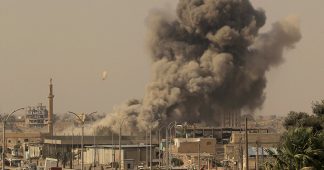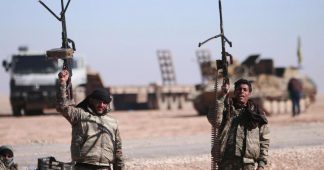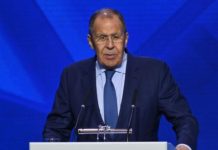By Prof. Marcello Ferrada de Noli,
SWEDHR chairman and chief-editor of The Indicter
January 2018
The television network RT asked me for a comment around the recent visit to Raqqa done by the USAID program chief together with the CENTCOM Commander. [1]
Before to answer the items on the humanitarian situation in Raqqa associated with the reconstruction issue –80 percent of Raqqa dwellings remain “inhabitable”, according to the UN–, I will develop on the current U.S. geopolitics in the area, against the backdrop of the U.S. emerging ‘Plan B’ on Syria (in my tweet of 18 January 2018, below).
 So far, the implementation of this new design has signified the virtual occupation of nearly a third of Syria’s territory. A hallmark of the situation consisting in the illegal character of the occupation.
So far, the implementation of this new design has signified the virtual occupation of nearly a third of Syria’s territory. A hallmark of the situation consisting in the illegal character of the occupation.
The first project of the US on Syria aimed to obtain a regimen change. It was pretty much a “default” policy applied by the US in the Middle East at the times of the Obama / Hillary Clinton administration. Partly of its mechanism has been described by Senator Dick Clark (an excerpt of Senator Clark’s declarations is found in the video here below. Click on the image for the excerpt-footage).
 The strategy of “regime change”, which can we call “U.S.Plan A on Syria”, failed.
The strategy of “regime change”, which can we call “U.S.Plan A on Syria”, failed.
The Syrian government –with help of its allies Russia, Iran and Hezbollah- instead continues victorious and unabated its pursue to retake the full sovereignty of its nation’s territory.
From an humanitarian angle, the failure of the said Plan A conveyed disastrous consequences. The number of fatalities due to the war in Syria have reached 400,000. To that, a massive displacement of refugees has to be added.
Furthermore, viewed in geopolitical and military terms, the strategy of establishing, funding, arming and training a miscellaneous jihadist opposition was also a setback, or even backfiring – as it ended fostering the combat capability of ISIS forces, through US armament which made its way to ISIS hands. (See The Hill report in the box below).
The optimism which emerged when Donal Trump became the U.S. president was of brief duration. The hope about a possible stop of US interference in Syria, based on Trump’s declarations while he was still a candidate, vanished when President Trump announced that he had delegated to the Pentagon and his Defense Minister Mattis, the tasks of profiling and give expression to U.S. military actions abroad. [2]
Unlike the situation during the Obama administration, it is now up to the Pentagon to decide specific targets and scope of military operations.
However, from a human rights perspective, the new Pentagon’s ‘free hands’ status has conveyed a high toll of civilian casualties as result of the extensive bombing by the US in Syria.
Anticipating the humanitarian catastrophe in the Syrian areas subjected by the US-led coalition’s bombardment, The New York Times reported in April 2017 that the US military had already increased the civilian casualties in Somalia and Yemen as the result of Pentagon’s new “free” doctrine. [3]
80% of Raqqa was left “uninhabitable” – UN
As a result of this new “rules of engagement” in the US bombing, the civilian population of Raqqa and areas around in northern Syria have suffered huge casualties. New data processed by Airwars regarding non-combatant deaths caused by the US-led coalition during 2017, result in figures up to “6,102 civilians estimated killed”. [4] The organization remarks that the civilian fatalities of 2017 represent 65% of all civilian deaths caused by the Coalition, that have been recorded by Airwars since 2014.
New data processed by Airwars regarding non-combatant deaths caused by the US-led coalition during 2017, result in figures up to “6,102 civilians estimated killed”. [4] The organization remarks that the civilian fatalities of 2017 represent 65% of all civilian deaths caused by the Coalition, that have been recorded by Airwars since 2014.
This statistically significant increasing in the epidemiology of fatalities among civilians in areas bombarded by the US-led coalition, shows the impact of the new Trump doctrine of giving “free hand” to the military (which now assess by themselves the risk of civilian casualties resulting from their operations).
In Raqqa alone, during the lasted Coalition campaign to recapture the city from ISIS, the balance was an estimate of 1,800 civilian casualties. [5] And according to a UN report, 80% of Raqqa was left “uninhabitable” ensuing the battle. [6]
The priorities in “reconstructing” the battered city and territory around are instead militarily
The recent visit to Raqqa by the head of the USAID program, Mr Mark Green, accompanied by the chief of the U.S. Central Command, General Joseph Votel, was interpreted in some media as an on-site assessment for a future reconstruction plan of Raqqa –to be done by the U.S. government. It was otherwise noted that the visit constituted “the most senior U.S. civilian official of the Trump administration” in Raqqa, after the defeat of ISIS. [1]
In fact, the media reports on the visit focused mainly on declarations by the General Joseph Votel, who emerged as the central gestalt of the delegation.
What the western media failed to mention, is that three days before the visit of Votel and Green it was known that the US military had initiated the reconstruction of the formerly Syrian Air-force base at al-Tabqa, located near Raqqa. So, the exploration-visit in Raqqa and surrounding areas may have mainly been relevant to construction/reconstruction assessments of the said usurped military airbase in al-Tanf, which is legal property of Syria.
The Al-Tabqah Military Airbase (photo below) is not the only military compound that the US has unilaterally decided to establish. The other military base is situated in al-Tanf, near the border with Iraq. [7]
#svpolUSAID
Regarding the kind of projects that USAID would be prone to support in the area, those will be definitely tied to the current US geopolitical project. That is what USAID is all about.
Propaganda-wise, the ‘Plan B’ geopolitical project rests on two premises which are under construction. One is the collapse of the peace talks in Geneva (and the corresponding boycott of the Sochi meeting) – see down below. The other premise is an expected international support for a direct military intervention in Syria (nearly, a deepening of the operations that have already started) motivated in staged “chemical attacks” massacres. [8]
One pivotal element in the staging of those “chemical-attack” false flags is the presence of “White Helmets” in those territories. The White Helmets and other “humanitarian” organizations financed by the U.S. have been the channels for delivering the “testimonies” from the staged scenarios.
The point being that USAID is one main financing source of the White Helmets and similar ‘humanitarian’ organizations operating in the propaganda campaign against Syria. [9] Naturally, a similar initiative implemented by USAID in the Syrian zones now under direct US military control or influence, can be expected.
One other classical role of USAID in that kind of ‘reconstruction’ endeavours has been the fostering and/or coordination of U.S. corporate investments profiting in such war-related areas –wars in which the US has had the initiative in bolstering. [10] And of course, the boost in exports of US products, even if this have resulted in detriment of the economic development of the ‘helped’ regions. [11]
Meanwhile in Washington. The US ‘Plan B’ on Syria is officially announced
David M. Satterfield, Acting Assistant Secretary of State for Near Eastern Affairs, is a representative voice of the Trump administration. Among other tasks, he was entrusted to lead the US delegation to the peace talks on Syria in Kazakhstan, September 2017. [12] So, when he is now declaring at the US Congress that the US has already an “alternative plan” in case the peace talks on Syria would not prosper, we have to attribute hos message a great relevance. Satterfield’s declarations are to be held as the tip of the iceberg regarding the US Plan B on Syria.
The Moon of Alabama reports: [13]
“Testifying before the Senate Foreign Relations Committee on Thursday, David Satterfield, the acting assistant secretary of state for Near Eastern affairs, outlined US goals in Syria as finishing off IS, stabilizing northeastern Syria and countering Iranian influence.”
And The Siver Times [14], as well as Kurdistan 24, report: [7]
“On Thursday, Acting Assistant Secretary of State for Near East Affairs, David Satterfield, revealed to the Senate Foreign Relations Committee that the USA had an alternate plan for Syria, in the event that the UN-sponsored talks in Geneva failed to produce an agreement. “
I was in Geneva on the 28 of November, when the peace talks recommenced. From what I could gather, the US administration seemed rather to support the “dialogue-not-possible” stance of their political proxy forces.
And with regard to the Sochi talks, which really are an opportunity for a final Peace Settlement on Syria, Mr Satterfield has been prominent in the campaign opposing the event, nevertheless his arguments have been fact-based rebutted and demolished by Ms Maria Zakharova (photo below, at right). [15]
And, precisely as Ms Zakharova could anticipate already on January 12, today the “Syrian opposition” announced that they will not attend the Sochi talks.
In my interpretation, the US need the collapse of the peace talks as a pretext to advance and consolidate its occupation of Syria. And the ultimate geopolitical goal is not only the fragmentation of Syria. By means of giving the the Kurdish administration the notion of sovereignty on the occupied territory, and have their proxies to “invite” the US forces in, the Pentagon plans to solve the gross legal problem of their unauthorized military staying in Syria.
The ultimate geopolitical aim is, however, the further utilization of the fragmented area (which constitutes about the third of Syria’s territory). Once that the ‘legal’ status in northern Syria has been achieved, the U.S. will stay to implement its goals to destabilize not only Syria, but also Iran, and converting the Middle East in its new backyard.
The U.S. and allied EU financial interests –for the occasion colluded with Saudi Arabia– will not end its warmongering pursuing until their long-time conceived oil-pipe project crystallizes.
And if that strategy in northern territories of Syria would fail –for instance due to developments in the Turkish offensive– the U.S. will try to enter in Syria from the South, most likely with help of “chemical-attack” false flags in the area. That is my interpretation after Tillerson’s announcing that US will not tolerate “more chemical attacks” by Syria. [16]
 That the Trump administration, or to put it more appropriate, that the Pentagon has decided to aggressively confront Iran is not a speculation. The U.S. government has unequivocally declared that its troops will remain in Syria, regardless if ISIS would be completely defeated. [17]
That the Trump administration, or to put it more appropriate, that the Pentagon has decided to aggressively confront Iran is not a speculation. The U.S. government has unequivocally declared that its troops will remain in Syria, regardless if ISIS would be completely defeated. [17]
The military occupation covering a third of Syria’s territory
 Above: Map from Anadolu Agency, published in Orient Net [18]
Above: Map from Anadolu Agency, published in Orient Net [18]
The yellow part is about an area comprising estimated 11,583 square miles, which is the equivalent of a third of the territory of Syria.
Raghida Dergman, founder and Executive Chairman of Beirut Institute, recently wrote in Huffington post: [19]
“US presence in Syria is massive and involves thousands of troops in several strategic bases…The richest one-third of Syria’s territory is effectively under US control.”
A closer demographic look indicates that in the area lives nearly a quarter of the population of Syria.
How many U-S- troops are already in Syria is not possible to ascertain. When the U.s. government officially reported that there were 500 troops, the figure was instead 2,000 –as later acknowledged. Now that the official figure become 2,000 one could just wonder how many thousands that figure could mean in reality.
According to Orient News Net, which sourced its information in the Turkish Anadolu Agency, the above map would show the ten sites were U.S. troops were stationed by July 2017: “Two airbases, eight military points in PKK/PYD-controlled areas. US Special Forces located in military points in Hasakah, Raqqa and Manbij.” [18]
 Above: Another map published by Anadoluy Agency, dated 12 October 2017.
Above: Another map published by Anadoluy Agency, dated 12 October 2017.
The RT questions
1. The Coalition said it will focus on restoring the basic needs in Raqqa (demining, clearing the roads, getting electricity, sewage and water). Do you think it’s enough for the refugees and former resident to return and come back to normal life in the city?
To clear out landmines and reestablish water and electricity is of course good, but way far from enough. The UN estimates that 80% of the houses were Raqqa inhabitants lived is now, I quote, “uninhabitable”. [6]
People cannot sleep over an electric wire or cover themselves with water. What the people need is the reconstruction of their houses, they need a roof, walls, etc. And it is not only about private dwellings. Services have to be restored, hospitals, schools, etc., which imply a profound reconstruction effort.
Michele Kelemen, NPR correspondent who traveled in Raqqa with the USAID program head, Mr Mark Green, and CENTCOM Commander, General Joseph Votel, declared in an interview, “They don’t call it nation building anymore. That’s for sure. They say that it’s stabilization.” [20]
My comment is that “Stabilization” is a geopolitical notion implying the ending of hostilities or at least the obtaining of a status quo. But what the US is doing in northern Syria is clearly the opposite, it is destabilization, and even implementing the territorial fragmentation of the country.
2. How the international community should approach the reconstruction of Raqqa?
The issue should be taken at UN different bodies, not only at the Security Council. Secondly, foreign-aid institutions at different richer countries, in Europe for instance, should be channel aid to a reconstruction fund established and administered by the EU.
3. Up to 80% of the city had been destroyed during the liberation from ISIL. In your opinion, who should bear the burden and lead the effort of rebuilding it?
A direct responsibility should be placed on those countries participating in the military coalition that bombed Raqqa and contributed to the destruction of 80% of the city dwellings.
To argue that is was ISIS the primarily responsible for the destruction of Raqqa, because the fight aimed to recapture the city from ISIS hands, it can hardly take away the responsibility of those who ordered the bombing. An aerial bombing and artillery that – viewing the destruction results– targeted residence houses and community institutions in a massive, seemingly indiscriminate fashion.
Another relevant issue here is to assess what responsibility the powers that decimated Raqqa had directly or indirectly in the establishment of ISIS and even in its weaponry.
[1] Lesley Wroughton, “U.S. aid chief visits Raqqa amid stabilization push“. Reuters, 22 January 2018.
[2] Simon Tisdall, “Donald Trump’s hands-off approach gives US military free rein“. The Guardian, 14 June 12017.
[3] Helene Cooper, “Trump Gives Military New Freedom. But With That Comes Danger“. The New York Times, 5 April 2017.
[4] Alex Hopkins, “Airwars annual assessment 2017: civilians paid a high price for major Coalition gains“. Airwars.org, 18 January 2018.
[5] Samuel Oakford, “More than 1,800 civilians killed overall in defeat of ISIS at Raqqa, say monitors.” Airwars.org, 19 Octobre 2017.
[6] Andrew Illingworth, “US-backed forces succeed in making Raqqa 80 percent “uninhabitable”. AMN, 20 Octobre 2017.
[7] Lurie Mylroie, “US to establish two military bases in eastern Syria as tensions with Turkey rise.” Kurdistan 24, 17 January 2018.
[8] M Ferrada de Noli, “From Timisoara to Khan Shaykhun. Part I: The Staged-Massacre Routine for Regime Change“. The Indicter Magazine, 24 October 2017.
[9] “A closer look: Delivering critical supplies to Syrians“. Devex, 8 September 2015.
[10] Andrey Panevin, “Corporations Are The New Conquistadors : Ukraine“. MintPress News, 19 February 2015.
[11] Julie Lévesque, “Haiti, Five Years After the Earthquake: Fraudulent Reconstruction Under Military Occupation“. Global Research, 15 January 2015.
[12] U.S. Dept of State, Office of the Spokesperson, “Acting Assistant Secretary of State David M. Satterfield Travel to Astana, Kazakhstan for Talks on Syria“. 12 September 2017.
[13] “Syria – U.S. Traps Itself , Commits To Occupation, Helps To Sustain The Astana Agreement“. Moon of Alabama, 15 January 2018.
[14] “Iran denounces USA ‘conspiracy’ against Syria“. The Siver Times, 17 January 2018.
[15] See “Remarks by David Satterfield, Acting Assistant Secretary of State, Bureau of Near Eastern Affairs”, in “Briefing by Foreign Ministry Spokesperson Maria Zakharova, Moscow, January 12, 2018“.
[16] Sara Elizabeth Williams, “Rex Tillerson blames Russia for Syrian ‘chemical weapons’ attacks“. The Telegraph, 23 January 2018.
|17] Gardiner Harris, “Tillerson Says U.S. Troops to Stay in Syria Beyond Battle With ISIS“. The New York Times, 17 January 2018.
[18] “AA’s map of US bases in Syria infuriates Pentagon“. Orient News Net, 20 July 2017.
[19] “The point of separation between the US and Russia in Syria”. Huffingtonpost.com, 13 January 2018.
[20] Michele Kelemen, “What The U.S. Presence Is Doing In Raqqa Despite Wishes Of Syrian Government“. NPR – National Public Radio, 22 January 2018.
 Prof. Marcello Ferrada de Noli (at left, key note at the Geneva Press Club conference, Nov 2017) is professor emeritus of epidemiology (research focus on Injury epidemiology), medicine doktor i psykiatri (PhD, Karolinska Institute), and formerly Research Fellow at Harvard Medical School. He is the founder and chairman of Swedish Professors and Doctors for Human Rights and editor-in-chief of The Indicter. Also publisher of The Professors’ Blog, and CEO of Libertarian Books – Sweden. Author of “Sweden VS. Assange – Human Rights Issues.”
Prof. Marcello Ferrada de Noli (at left, key note at the Geneva Press Club conference, Nov 2017) is professor emeritus of epidemiology (research focus on Injury epidemiology), medicine doktor i psykiatri (PhD, Karolinska Institute), and formerly Research Fellow at Harvard Medical School. He is the founder and chairman of Swedish Professors and Doctors for Human Rights and editor-in-chief of The Indicter. Also publisher of The Professors’ Blog, and CEO of Libertarian Books – Sweden. Author of “Sweden VS. Assange – Human Rights Issues.”
Media contributions: Op-ed articles in Dagens Nyheter (DN), Svenska Dagbladet (Svd), Aftonbladet, Västerbotten Kuriren, Dagens Medicin, the Journal of the Swedish Medical Association (Läkartidningen) and other Swedish media. Contributing articles in Global Research (Canada) and Izvestia (Russia). Exclusive interviews in Dagens Nyheter (DN), Expressen, SvD and Aftonbladet, TASS, El Telégrafo, Sputnik, and in Swedish TV channels Svt 2, TV4, TV5. Other international TV interviews: Norway TV, Italy TG, RT, Russia Channel 1, Rossiya 24, TVN Chile, Italian and UK channels.
Reachable via email at chair@swedhr.org, editors@theindicter.com
Twitter: @Professorsblogg













